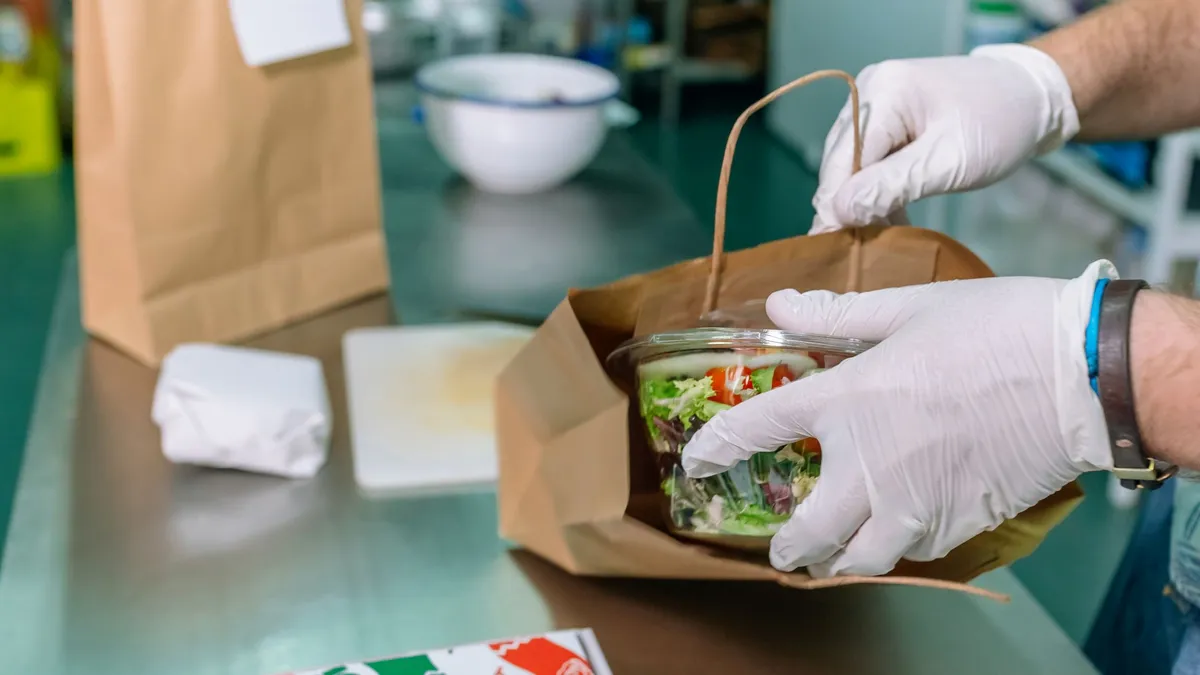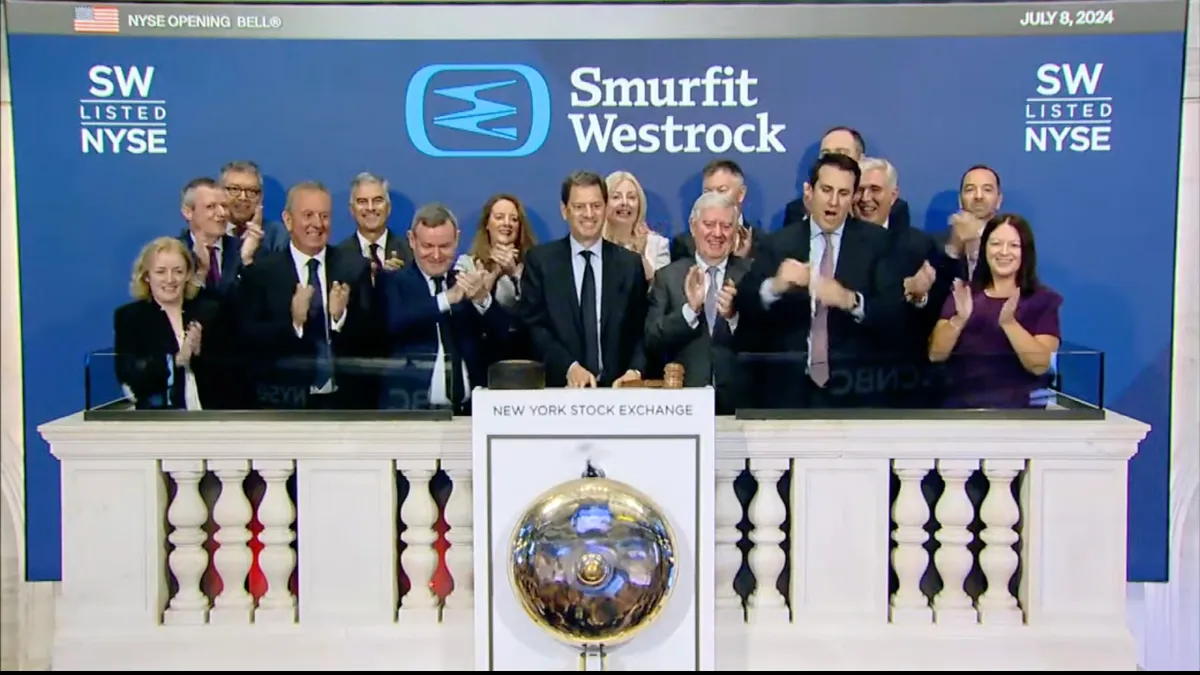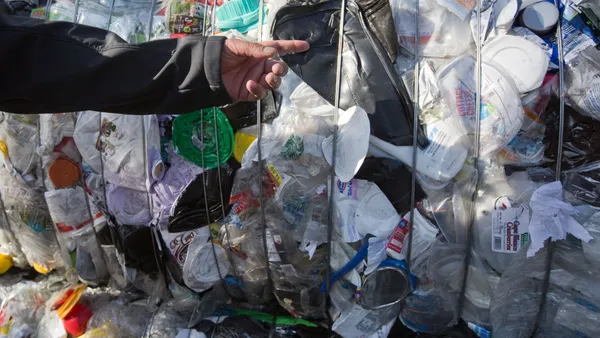Smurfit Kappa and WestRock sent shockwaves through the fiber packaging sector last week when they confirmed potential plans to create a company known as Smurfit WestRock. Analysts suggest the deal might face less pushback than other packaging M&A transactions have in the past — even given the immense size of the company that would result.
The potential deal would create “the largest containerboard company in the world” with combined equity value of up to $24.5 billion and sales of $35 billion, BofA Securities analysts wrote in a note Thursday. They characterized such a deal as “positive” overall and estimated the “collective equity could yield 30%+ upside for shareholders over time.”
Ryan Fox, corrugated packaging market analyst at Bloomberg Intelligence, said that such a deal “stands to posture the new entity as a global, one-stop-shop for brands that have manufacturing or distribution in many countries,” adding that the “single-source mentality may allow brands to accomplish two main objectives: lower pricing and consistency in packaging.”
The possible deal appears to be mainly driven by potential cost synergies and opportunities for geographic and product expansion, the BofA report said. It explained that Ireland-based Smurfit Kappa’s U.S. presence largely consists of converting operations but not as many mills, while Atlanta-based WestRock has no mills or converting facilities in Europe.
Michael Roxland, senior paper and packaging analyst at Truist Securities, also noted the importance of geographic expansion in a recent report, highlighting Smurfit Kappa’s growth in the U.S. over the last decade.
“A potential merger with WestRock affords them a significant scale to really become a notable player in the U.S. market,” he said in an interview. “It’s a market that also, relative to Europe, is increasingly consolidated; it’s less fragmented. Once we get past this destocking that the industry has gone through the last year, you will see the return to growth.”
BofA analysts also believe WestRock’s consumer packaging and boxboard operations, comprising about 30% of its business, are important to Smurfit Kappa. “Smurfit has been aggressively promoting sustainability but has been doing so with little consumer, retail-shelf packaging,” the report said.
On the cost side, the report noted that if the deal happens, it would follow a recent $90 per ton drop in North American containerboard pricing and a 260 euros per metric ton drop in European pricing. “Our past research suggests that WestRock is generally a higher-cost producer in containerboard boxboard in North America ... which is part of the reason why there are still self-help earnings to be garnered,” it said.
Beyond these initial observations, sources in the fiber packaging industry still have a lot of questions about next steps for a potential transaction — in part because the news caught the sector by surprise.
“I don’t think many people were expecting this,” Roxland said.
Seeking approval
If the companies do formalize a transaction agreement, regulators will have to determine whether a combination would stifle marketplace competition and necessitate divestitures.
For example, in 2012 the U.S. Department of Justice required International Paper and Temple-Inland to divest three containerboard mills before approving the $4.3 billion merger. DOJ said that IP and Temple-Inland were the largest and third-largest North American containerboard producers, respectively, and the originally proposed merger would let one new company dominate 37% of North America’s containerboard capacity.
Fox suggested that divestiture requirements would be less likely for a Smurfit-WestRock deal. “Smurfit Kappa's presence in the U.S. is limited to a few states while WestRock's presence is much more robust,” he said. “If anything, we could expect to see some consolidation of plants, especially where box plants are well below their capacity.”
Plus, last week WestRock sold its remaining stake in RTS Packaging to Sonoco. The deal included a WestRock paper mill in Chattanooga, Tennessee.
That being said, the two entities combined would represent about 35% of Mexico’s containerboard market and 16% of Brazil’s, according to BofA. BofA analysts noted in their report that they “don't see lots of regulatory risk (overlap) other than in Mexico and Brazil.”
Regulators could potentially examine whether a business combination would affect competition in the southwest region of North America. Smurfit Kappa’s U.S. facilities generally are concentrated in South Central and Southwest states, and it obtained facilities in Mexico a decade ago via an acquisition. Last year WestRock obtained four paper mills, nine corrugated packaging plants and six high graphic plants throughout Mexico as part of its Grupo Gondi acquisition.
WestRock’s streamlining
This year, WestRock executives repeatedly referenced during earnings calls a “footprint optimization” effort that involves closing inefficient or underperforming mills and facilities. The company has announced at least six facility closures this year that, when finished, will result in more than 1,000 layoffs.
Analysts did not take a position on whether WestRock may have intended for this level of closures all along, or if the company was looking to streamline its portfolio ahead of a potential merger.
“The company has done a really good job of streamlining its operations ... But this is affecting communities, it's affecting people's lives,” Roxland said. “Whether it was spurred by Smurfit Kappa or not, I don't know.”
Fox shared similar insight, noting that closing plants helps WestRock “shrink the denominator of the calculation,” which improves the return on invested capital. “It just so happens that these moves coincide with a contraction in box demand. Could it have also been to prepare for this merger? Yes, that is also a potential consideration, in my view,” he said.
BofA’s report predicts a merger could bring a “long-term turnaround story for [WestRock] margins” and the paper company “likely views the combination as expediting its transition and realignment.”
Deal disruption?
International Paper twice made a bid for Smurfit Kappa in 2018. But Smurfit rejected the proposals because the board was “resolute in its belief that the best interests of the Group’s stakeholders are served by pursuing its future as an independent company.”
IP tried to engage Smurfit for three months before walking away, citing lack of engagement from Smurfit’s management. Irish law prevented IP from initiating another attempt within 12 months.
Despite some situational similarities, analysts said a potential Smurfit-WestRock combination exhibits significant differences from the IP proposal.
“One of the big differences between this deal and the prior one is that International Paper was bidding for Smurfit Kappa, and in this case Smurfit Kappa is doing what seems to be a merger of equals,” Roxland said. Even so, he said Smurfit appears to be attempting to buy WestRock based on the initial details about how the deal might work.
Fox offered loose conjecture on why Smurfit might pursue WestRock just five years after rejecting bids from a company of a similar size. “Perhaps, Smurfit wanted to be the initiator or the one making the acquisition?” Fox speculated. Or, with WestRock’s series of facility closures this year and last year, “perhaps [Smurfit Kappa] viewed [WestRock] as being open to the merger and/or looking for help in correcting their course,” Fox said.
And just because these companies are considering a merger doesn’t mean close competitors couldn’t launch their own bids. Other players’ opportunities “might come during the integration process if there are disruptions or hiccups,” Fox said.
However, the BofA report noted some doubt that IP, Packaging Corporation of America or other companies like DS Smith would try to get involved. “In particular, given market shares and history, we don't see IP trying to acquire either [Smurfit Kappa] or [WestRock],” it said. “However, to the extent that a multi-substrate or pan-Atlantic strategy makes sense this could increase M&A review” of portfolios for these and other players, “like Graphic Packaging.”
The potential transaction is also interesting because of the companies’ overlapping histories and growth through past acquisitions, Fox said.
Dublin-based Smurfit Kappa’s current iteration grew from a series of deals, including the combination of Jefferson Smurfit Group and Kappa Packaging in 2005. Through a complex series of transactions, a subsidiary of JSG had previously acquired Chicago-based Stone Container Corp. in 1998 to form Smurfit-Stone. The North American-focused Smurfit-Stone, then separate from Smurfit Kappa, later filed for bankruptucy in 2009 during the global recession. It was purchased by RockTenn in 2011. WestRock was later created through the merger of RockTenn and MeadWestvaco in 2015, both of which had also been formed through prior combinations.


















